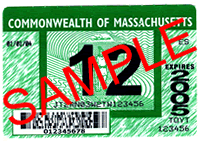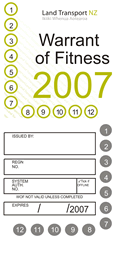This article needs additional citations for verification. (June 2023) |


Vehicle inspection is a procedure mandated by national or subnational governments in many countries, in which a vehicle is inspected to ensure that it conforms to regulations governing safety, emissions, or both. Inspection can be required at various times, e.g., periodically or on the transfer of title to a vehicle. If required periodically, it is often termed periodic motor vehicle inspection; typical intervals are every two years and every year. When a vehicle passes inspection, often a sticker (inspection decal or inspection sticker) is placed on the vehicle's windshield or registration plate to simplify later controls, but in some countries—such as the Netherlands since 1994—this is no longer necessary. Most US inspection decals/stickers display the month's number and the year.
In some jurisdictions, proof of inspection is required before a vehicle license or license plate can be issued or renewed. In others, once a vehicle passes inspection, an inspection decal is attached to the windshield or registration plate, and police can enforce the inspection law by seeing whether the vehicle displays an up-to-date decal.
There has been some controversy over whether periodically inspecting motor vehicles is a cost-effective way to improve road traffic safety.[1][2][3] Recent analysis of changes in safety inspection procedures in the United States have cast renewed doubt on the effectiveness of these inspections.[4]
- ^ "Cost-Effectiveness of Periodic Motor Vehicle Inspection - University of Michigan (U.S.A.) Transportation Research Institute" (PDF). January 1985.
no credible evidence was found which demonstrates significant changes in vehicle-defect accidents as a result of [periodic motor vehicle inspections
- ^ "Cost Effectiveness of Periodic Motor Vehicle Inspection" (PDF). Report for the (Australian) Federal Office of Road Safety. April 1999.
Using the New Zealand data... logistic regression analysis [showed considerable] statistical uncertainty... The Victorian analysis of potential periodic roadworthiness certification safety benefits was not entirely conclusive [;] likely to be much less than required to make an annual periodic scheme cost effective
[permanent dead link] - ^ Merrell, David; Poitras, Marc; Sutter, Daniel (1999). "The Effectiveness of Vehicle Safety Inspections: An Analysis using Panel Data". Southern Economic Journal. 65 (3): 571–583. doi:10.2307/1060816. JSTOR 1060816.
We examined the effectiveness of state automobile safety inspections and present new evidence from a panel of the 50 states for the years 1981-1993. Our approach incorporated several innovations over previous studies of safety inspections; most significantly, we estimated a fixed-effects model that incorporated state-specific shifts in casualty rates. We found no evidence that inspections significantly reduce fatality or injury rates. Our study also provides evidence on the effects of speed limits, seat belts, and Peltzman's offsetting behaviour hypothesis.
- ^ Hoagland, Alex; Woolley, Trevor (March 2018). "It's No Accident: Evaluating the Effectiveness of Vehicle Safety Inspections". Contemporary Economic Policy. 36 (4): 607–628. doi:10.1111/coep.12284. S2CID 157741209.
Utilizing a synthetic controls approach, we conclude that ending requirements [for safety inspections] did not result in a significant increase in the frequency or intensity of accidents due to car failure, implying that the consumer and government expenditures used for inspections could be reallocated to other areas of travel safety.